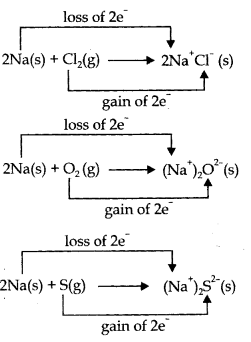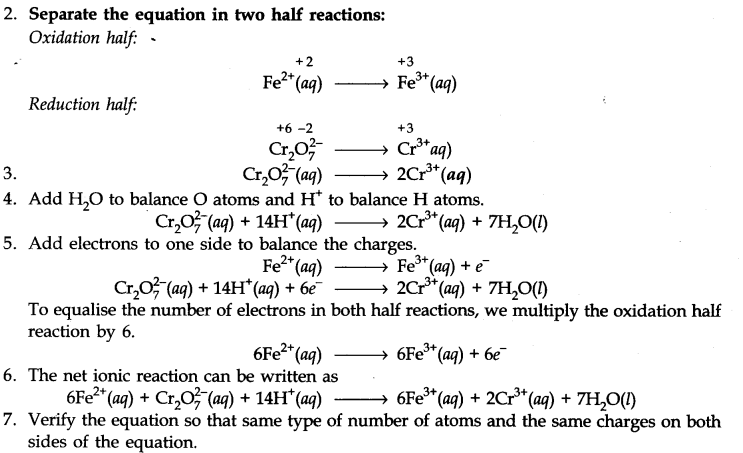Notes For All Chapters Chemistry Class 11 CBSE
• Oxidation
Oxidation is defined as the addition of oxygen/electronegative element to a substance or rememoval of hydrogen/ electropositive element from a susbtance.
For example,
• Reduction
Reduction is defined as the memoval of oxygen/electronegative element from a substance or addition of hydrogen or electropositive element to a substance.
For example,
• Redox Reaction in Terms of Electron Transfer Reaction
A few examples of redox reaction on the basis of electronic concept are given below:
According to electronic concept every redox reaction consists of two steps known as half reactions.
(i) Oxidation reaction: Half reactions that involve loss of electrons are called oxidation reactions.
(ii) Reduction reaction: Half reactions that involve gain of electrons are called reduction reactions.
Oxidising agent: Acceptor of electrons.
Reducing agent: Donar of electrons.
• Competitive Electron Transfer Reactions
To understand this concept let us do an experiment.
Place a strip of metallic zinc in an aqueous solution of copper nitrate as shown in Fig. After one hour following changes will be noticed.
(i) Strips becomes coated with reddish metallic copper.
(ii) Blue colour of the solution disappears.
(iii) If hydrogen sulphide gas is passed through the solution appearance of white ZnS can be – seen on making the solution alkaline with ammonia.
• Oxidation Number
It is the oxidation state of an element in a compound which is the charge assigned to an atom of a compound is equal to the number of electrons in the valence shell of an atom that are gained or lost completely or to a large extent by that atom while forming a bond in a compound.
• Rules for Assigning Oxidation Numbers
(i) The oxidation number of an element in its elementary form is zero.
For example, H2, 02, N2 etc. have oxidation number equal to zero.
(ii) In a single monoatomic ion, the oxidation number is equal to the charge on the ion. For example, Na+ ion has oxidation number of +1 and Mg2+ ion has +2.
(iii) Oxygen has oxidation number -2 in its compounds. However, there are some exceptions.
Compounds such as peroxides. Na202, H202
oxidation number of oxygen = – 1 In OF2
O.N. of oxygen = +2 02F2
O.N. of oxygen = +1
(iv) In non-metallic compounds of hydrogen like HCl, H2S, H2O oxidation number of hydrogen = + 1 but in metal hydrides oxidation number of hydrogen = -1
[LiH, NaH, CaH2 etc.]
(v) In compounds of metals and non-metals metals have positive oxidation number while non-metals have negative oxidation number. For example, In NaCl. Na has +1 oxidation number while chlorine has -1.
(vi) If in a compound there are two non-metallic atoms the atoms with high electronegativity is assigned negative oxidation number while other atoms have positive oxidation number.
(vii) The algebraic sum of the oxidation number of all atoms in a compound is equal to zero.
(viii) In poly atomic ion the sum of the oxidation no. of all the atoms in the ion is equal to the net charge on the ion.
For example, in (C03)2—Sum of carbon atoms and three oxygen atoms is equal to -2.
Fluorine (F2) is so highly reactive non-metal that it displaces oxygen from water.
Disproportionation Reaction. In a disproportionation reaction an element in one oxidation state is simultaneously oxidises and reduced.
For example,
Hence, the oxygen of peroxide, which is present in -1 oxidation state is connected to zero oxidation state and in 02 and in H2O decreases to -2 oxidation state.
• Fractional Oxidation Numbers
Elements as such do not have any fractional oxidation numbers. When the same element are involved in different bonding in a species, their actual oxidation states are whole numbers but an average of these is fractional.
For example, In C302
Fractional O.N. of a particular element can be claculated only if we know about the structure of the compound or in which it is present.
• Balancing of Redox Reactions
(i) Oxidation Number Method. Following steps are involved:
(ii) Write the correct formula for each reactant and product.
(b) By assigning the oxidation change in oxidation number can be identified.
(c) Calculate the increase and decrease in oxidation number per atom with respect to the reactants. If more than one atom is present then multiply by suitable coefficient.
(d) Balance the equation with respect to all atoms. Balance hydrogen and oxygen atoms also.
(e) If the reaction is carried out in acidic medium, use H+ ions in the equation. If it is in basic medium use OH– ions.
(f) Hydrogen atoms in the expression can be balanced by adding (H20) molecules to the reactants or products.
If there are the same number of oxygen atoms on the both side of equation then it represents the balanced redox reaction.
(ii) Half Reaction Method. In this method two half equation are balanced separately and than added together to give balanced equation.
• Redox Reactions as the Basis for Titration
Potassium Permanganate Titration: In these titrations potassium permanganate (pink in colour) acts as an oxidising agent in the acidic medium while oxalic acid or some ferrous salts acts as a reducing agents.
The ionic equation can be written as:
These are the examples of redox titration.
On both these titrations, potassium permanganate itself acts as indicator. It is commonly known as self indicator. The appearance of pink colour in the solution represents the end points.
Potassium Dichromate Titration: In place of potassium permanganate, potassium dichromate can also be used in the presence of dil. H2S04. The ionic equation for the redox reaction with FeS04 (Fe2+ ions) is given.
• Limitation of Concept of Oxidation Number
According to the concept of oxidation number, oxidation means increase in oxidation number – by loss of electrons and reduction means decrease in oxidation number by the gain of electrons. However, during oxidation there is decrease in electron density while increase in electron density around the atom undergoing reduction.
• Redox Reactions and Electrode Processes—Electrochemical Cells
A device in which the redox reaction is carried indirectly and the decrease in energy appears as the electrical energy are called electrochemical cell.
Electrolytic Cell. The cell in which electrical energy is converted into chemical energy. Example, when lead storage battery is recharged, it acts as electrolytic cell.
Redox Reactions and Electrode Processes. When zinc rod is dipped in copper sulphate solution redox reaction begins hence, zinc is oxidised to Zn2+ ions and Cu2+ ions are reduced to metal.
• Redox reaction. Reactions in which oxidation and reduction occur simultaneously are called redox reactions.
• Oxidation. Involves loss of one or more electrons.
• Reduction. Involves gain of one or more electrons.
• Oxidising agent. Accepting electrons.
• Reducing agent. Losing electrons.
• Electrochemical cell. It is a device in which redox reaction is carried indirectly and decrease in energy gives electrical energy.
• Electrode potential. It is the potential difference between the electrode and its ions in solution.
• Standard electrode potential. It is the potential of an electrode with respect to standard hydrogen electrode.
• Electrochemical series. It is activity series. It has been formed by arranging the metals in order of increasing standard reduction potential value.










Leave a Reply